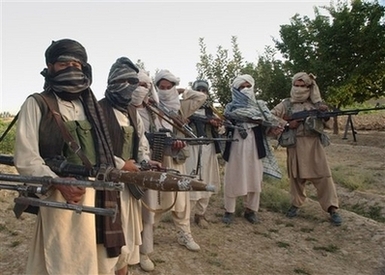
Lashkar-e-Taiba Resumes Operations Against Indian Forces in Jammu and Kashmir
Publication: Terrorism Monitor Volume: 7 Issue: 8
By:

After lying low for a few months following the November 2008 Mumbai carnage and the subsequent crackdown on its leadership and camps in Pakistan, Lashkar-e-Taiba (LeT) has once again resumed operations in the Indian state of Jammu and Kashmir (J&K).
LeT fighters engaged Indian regulars of 1 Para and 6 Btn. Rashtriya Rifles (a counterterrorism paramilitary created in 1990 for use in Kashmir) in a five-day firefight, beginning on March 20 in the Shamasbari forest range of Kupwara District, close to the Kashmir Line of Control (LoC) – a military control line constituting a de facto border between Indian and Pakistani-controlled Kashmir. The LeT claimed responsibility for the ambush on an army patrol party and the subsequent encounter in which 17 militants and eight soldiers (including a major) were killed (Kashmir Live, March 25; NDTV, March 24). The Indian Army ascribed its losses to the technical sophistication of the insurgents and their extensive use of GPS systems in the densely forested region. According to Brigadier Gurmit Singh; “The militants killed in the encounter were highly trained, well equipped. We have recovered the latest weapons, communication systems and maps from them” (Kashmir Observer, March 27).
Indian security agencies suspect the Pakistani army of involvement in the infiltration of the militants. The army’s suspicion is based on recovered snow gear, maps, GPS systems, a Thuraya satellite phone, rations and medicines (Kashmir Observer, March 27; RTT News, March 26). However, Pakistan has dismissed the idea that the Kupwara encounters were supported by government forces across the border.
In mid-March, almost a week before the Kupwara battle, at least three LeT terrorists successfully crossed the LoC and were later killed during a siege of the mosque in which they took refuge in the Kishtwar district of Jammu region (News Agency of Kashmir, March 14). One of the militants was identified as an LeT commander, Yusuf Gujjar (Indo-Asian News Service, March 14; Times of India, March 15).
The recovery of two Pakistan-made liquefied petroleum gas cylinders and four AK-47 assault rifles in the Mendhar area of Poonch District indicated militants successfully crossed the LoC late last month (Daily Excelsior [Jammu], March 22).
A day after the Army completed the operation in Kupwara, the LeT terrorists again made an unsuccessful attempt to enter the Kashmir Valley from the Gurez sector in Bandipora District and from the Hachamarg area of Handwara District (Times of India, March 28). Indian troops deployed at the LoC have confirmed large-scale attempts by Pakistan-based militants, mostly LeT and Hizb ul-Mujahidin (HuM) cadres, to infiltrate into the state through the forests of the Kupwara and Gurez sectors.
After recently overhauling its infrastructure in J&K, the LeT has reportedly vowed to continue lethal strikes against the security forces and vital installations in the state. Claiming responsibility for the Kupwara encounters, the LeT’s elusive spokesman, Abdullah (Gaznavi) Muntazir, told local media; “The encounter which ensued turned out to be a long-drawn-out battle… [it] should serve as an eye-opener for New Delhi… India should understand that the freedom struggle in Kashmir is not over… it is active with full force” (Rising Kashmir [Srinagar], March 25).
There is increasing concern in the Indian security establishment over the flourishing terror infrastructure across the border. Contrary to Pakistan’s claim to have shut down terror camps in Pakistan-administered Kashmir, unconfirmed reports in early March suggested the LeT has opened up more camps in Muzzafarabad, Mirpur and Kotli for the fresh recruitment and training of new cadres. According to Indian intelligence agencies, the LeT has positioned around 800 cadres under newly designated leaders in charge of J&K operations. The new leaders were identified by Indian intelligence sources as Shahji (a.k.a. Abu Anas), Hyder Bhayee (a.ka. Bilal, a.k.a. Salahuddin), Huzefa (a.k.a. Abdul Gaffar) and Walid, the LeT’s “top man for ammunition supply and finances” (Indian Express, March 7). The four senior LeT commanders reportedly replaced Mumbai attack masterminds Zaki-ur-Rehman Lakhvi, Zarar Shah and Yousuf Muzammil, all currently in Pakistani custody.
However, the Kupwara encounter took the Army and paramilitary by surprise and forced them to increase their level of preparedness to meet future infiltration attempts by Pakistan-based terrorists. Likewise, security has been beefed up along the LoC and around vital installations in J&K following intelligence inputs about impending attempts to infiltrate militants into Kashmir in the spring to sabotage the Parliamentary poll in the state. 183 paramilitary companies will be deployed to provide security for the elections (Hindu, March 31).
The infiltration attempt and subsequent encounter in Kupwara coincided with the first major violation of the bilateral ceasefire in the Uri sector of north Kashmir, in which Pakistani and Indian troops exchanged fire for several hours on March 20 (Rediff.com, March 21; Daily Times [Lahore], March 22).
The question remains as to how the LeT has been able to bounce back, even after Pakistan’s so-called crackdown following the Mumbai episode. Indian Prime Minster Manmohan Singh addressed this puzzle recently by saying the LeT has made a resurgence “because the government of Pakistan is either not able to control them or they are not willing to control them” (Indian Express, April 1).





